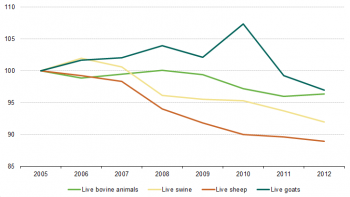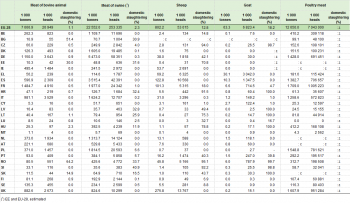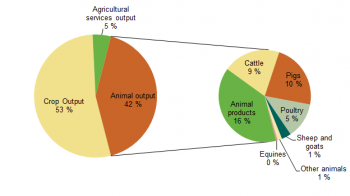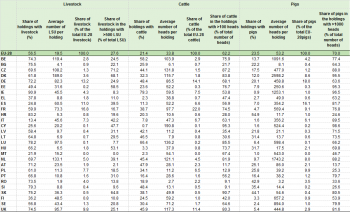Archive:Meat production statistics
- Data from November 2014. Most recent data: Further Eurostat information, Main tables and Database. Planned article update: (dd) Month YYYY(, hh:00).
This publication gives an overview of European meat production , according to the data provided to Eurostat by the Member States EU-28 in compliance with Regulation (EU) No1165/2008 concerning livestock and meat statistics. Data on livestock population categories are gathered from all EU Member States through a livestock survey conducted at least once a year (see Methodological Notes).

Source: Eurostat (apro_mt_lscatl), (apro_mt_lspig), (apro_mt_lssheep) and (apro_mt_lsgoat)

Source: Eurostat (ef_olslsuft) and (ef_olslsureg)
Main statistical findings
Since the decoupling of subsidies in 2003, following the mid-term review of the Common Agricultural Policy (CAP), the total numbers of livestock have decreased for the various species.
Between 2005 and 2013, there was a drop in total livestock (Figure 1). This trend continued until 2013 for pigs and sheep. However, the herds of bovine animals (+1.5 %) and goats (+0.9 %) stopped decreasing in 2013, which might indicate a slight recovery for cattle meat.
Sheep livestock showed the most pronounced fall (-11.6 %) for the 14 Member States[1] with more than 500 000 sheep, followed by live pigs (-8.6 %) for the EU-28. Cattle has fallen (-3 %) as well as goats (-2 %) for the five Member States[2] with more than 500 000 goats.
Greening of agricultural systems was one of the objectives pursued under the latest reform of the common agricultural policy. Livestock farmers are therefore required to adapt their farming systems if they wish to preserve their income and offer products geared to market need and to society’s demand for environmentally friendly farming practices.
According to the Farm Structure Survey (FSS), in 2010 nearly seven million holdings (6.92 million) reared livestock, representing 56.5 % of EU-28 farms. As a proportion of all farms, 23.5 % had pigs, 21.4 % had bovine animals (cattle, buffaloes, etc.), 18.7 % had broilers, 7.7 % had sheep and 4.4 % had goats.
From 2009 to 2013, there was a significant rising trend in poultry meat (Figure 2), which saw an overall increase of 7.03 %. Pigmeat also increased (2.65 %) while bovine meat decreased by 6.2 % and sheep and goat meat by 6.4 %.
The economic relevance of animal production in agricultural accounts is shown by the fact that 42 % (EUR 172 billion) of the total EU-28 agricultural output comes from it. Animal production covers two items: output for Animals and Animal products. Output for Animals, which represents 61 % of animal output, is the value of animals produced either directly for slaughter, or used alive for herd renewal or for further growing and fattening. Animal products account for the remaining 39 % and cover eggs, milk, wool, etc.
Slaughtering
Table 1 draws a general picture of European meat production based on the 2013 slaughtering statistics. Pigmeat was the most important meat category: nearly 22 million tonnes were produced, i.e. 51 % of annual production of all meats, followed by poultry meat with 12.7 million tonnes (30 %). Bovine meat production totalled 7.3 million tonnes (17 %) and the meat from sheep and goats accounted for only 758 000 tonnes, around 2 % of all meats.
The special case of ‘other slaughtering’
So-called other slaughtering is carried out other than in slaughterhouses. In the EU, it is a marginal phenomenon, primarily arising from own-consumption, and traditional or ritual slaughter (Table 2). It can be locally significant in part due to incomplete implementation of hygiene legislation. The EU has rigorous hygiene rules, and food is tracked at all stages of the production chain, including slaughtering, processing and distribution, in order to guarantee food safety throughout Europe (see data sources and availability).
In 2013, 77 % of other slaughtering was recorded in those Member States that joined the EU in 2004 or later. In relative terms, other slaughtering accounted for 13 % of total slaughtering in the 13 newest Member States and 0.5 % in the EU-15.
The general trend is a decrease: other slaughtering fell by 56 % in EU-28 between 2009 and 2013, but it remains at a significant level in Bulgaria and Romania. In Croatia, it was not possible in 2013 to differentiate figures for the two types of slaughtering. In Latvia, Slovenia and Lithuania, other slaughtering has decreased, especially for bovine animals, but the numbers remain significant for pigs, sheep and goats.
The contribution of the various species to other slaughtering is much higher for pigs (64.2 %) than for small grazing livestock (19.0 %) and bovine animals (16.8 %). For this latter category, ‘adult cattle’ (one year and older) account for 11.65 % and calves & young cattle for 5.15 %.
1.2 Beef and veal (bovine meat)
In terms of value, bovine animals represent 8.1 % of total agricultural output and 33 % of animal output, without taking account of animal products (e.g., milk).
In EU-28, between 2007 and 2013, the number of non-dairy cows decreased by 5 %, from 12.5 to 11.9 million heads (Figure 3). This trend was especially striking in EU-15 (compared with the other EU 28 countries). Indeed, the major part of the meat bovine herd is located in four Member States: France (34.5 %); Spain (14.9 %); the United Kingdom (13.0 %); and Ireland (9.1 %). Together, they represent more than 70 % of the European meat herd. This type of herd is susceptible to changes in the sector’s limited profitability and is thus sensitive to the level of subsidies from the common agricultural policy.
Between 2009 and 2013, production of meat from heifers and bulls fell in both EU-28 ( 10 %) and EU-15 ( 13 %). However, there has been an increase regarding veal, i.e. meat from calves (aged under 8 months) and young cattle (aged between 8 and 12 months), and for which production increased by around 27 % in the EU-28 and 30 % for EU-15 during this period.
Meanwhile, the average carcass weight has increased by 2 % for adult cattle (aged one year and over) and by 7 % for calves and young cattle.
Bovine production forecasts are expressed as Gross Indigenous Production (GIP), defined as the number of bovine animals slaughtered plus or minus the net exports of live bovine animals. This indicator is more likely to be produced based on current livestock rather than slaughtering.
Compared with pigmeat production, beef production has a longer production cycle (Figure 6), its feed efficiency is lower and its value of individual animals is higher. In addition, the diversity of animals produced for slaughter (feeding mode, age, dairy or meat breeds) makes the production systems more complex. All these factors have led to tight margins and low profitability. The purchasing power of consumers is also a key determinant of the level of meat consumption. This is noticeable especially in the beef & veal sector where prices are significantly higher than for pig (or poultry) meat. This explains why pigs and poultry are raised and consumed much more in Europe.
Pigmeat
As already highlighted, pigmeat is the major meat production in EU-28. The total number of pigs has decreased since 2004, but pigmeat production remained stable over the years or has even registered some peaks such as in 2007 and 2011. This reflects gains of efficiency in pig farming despite stronger regulatory constraints. This is more marked in EU-15 than in the other Members States (Figure XXXX). The total number of pigs has decreased from 2006 to 2013 by 10.3%. This trend can be explained mainly by lower profitability, due to economic and regulatory conditions, impacting the weakest farms. For instance Directive 2008/120/EC on the protection of pigs contributed in increasing the cost per sow in counterpart of their welfare. The larger pig farm size, as measured by their number of sows, appear as efficient in this context and they represent a higher share of the sector in EU-15 than in the other Member States. It reflects also disappearing of the smallest and less productive pig farming activities.
Meat from sheep and goats
Sheep and goat meat represents 1.4% of the total EU agricultural output. Based on the FSS in 2010, the 7.7% of farms have sheep and nearly half of the sheep belong to flocks over 500 heads. The share of goat farms is 4.4% and 51.5% of goats belong to flocks over 200 heads. These average figures smooth the contrasts between small herds, either in small rural farms or as side-production in larger ones, and larger herds, especially in regions with natural or environmental constraints. According to the legislation in force (see methodological notes), the 14 Members States with more than 500,000 sheep and the 5 Member States with more than 500,000 goats must provide statistics on the relevant livestock populations. Therefore all the figures presented refer to these countries. The 14 Member States reporting on sheep population can be displayed depending on the share of dairy ewes in the ewe flock (Table XX). The “Northern” countries have no or limited dairy production whereas dairy ewe mark sheep farming in the “Southern” countries.
The farming systems for sheep and goats in the Southern countries are comparable by complexity of their organisation to those for bovine animals in EU, with co-existing dairy and fattening flocks. Individual dairy animals are more profitable than meat animals and therefore they are more likely supported by technology than the meat animals (feeding, genetic progress, farm equipment, farmer education, etc.). Several types of meats are produced, either young animals from the dairy herd or heavier sheep from the meat herd, fattened on grassland or with feedstuff. Milk processing on farms is more frequent, as the daily milk volumes are lower than from cows’ milk, i.e. milk collection by a dairy is suitable only where dairy farm density on the territory is sufficient.
Between 2005 and 2013 the EU-28 sheep flock has been reduced by 10.96 million animals. During this latest year the trend continued to go down but the drop is smoother than in previous years, showing that maybe the sector is starting to be more stable. The EU drop reflects the important fall suffered in the main sheep meat producing countries (Figure XXXX). Spain lost 28% of its flock (6.4 million sheep), Portugal 29%), Ireland 24% and France 18%. The United Kingdom is by far the most important sheepmeat producer (20% of EU 28 production) lost by 4.7% of its flock. In contrast the sheep-flock grew in three countries, Romania (+20%) and Greece (+9%), where more than 90% of ewes are dairy ewes, and Sweden (+22%).
The overall contribution of goat meat to EU-28 meat production is modest (0.1%) and it is concentrated in five Member States which represent 80.8% of the EU goat meat production. It can be described as a by-product of dairy production. Goat slaughtering is recorded especially for completeness of the view.
Sheep and goat farming is possible in the areas with limited agronomic potentiality (rough grazing), but with low profitability per head. The trend is either increasing herd size or developping dairy production. It can also take profit of poor lands and be part to activity of diversified farms. It is therefore important for rural development policy and no specific support is designed for the product at EU level. Several Member States (Greece, Spain, Italy, the Netherlands, Poland, Portugal, etc.) introduced specific national support to sheep and goat within the Single Farm Payment under Article 68 of Regulation 79/2003. This may have limited the decrease.
Poultry meat
Poultry meat value represents 5.5% of the total agricultural output and 20.9 % of the animal output, which means approximately 21.3 billion Euros. Poultry meat production is thus relatively integrated. The production constraints from the legislation (environment, hygiene, welfare, etc.) have increased the production cost and the profitability thresholds (further commitments under quality schemes also increase the costs, but in counterpart of added value). In a competitive market, this favored development of larger poultry farms. According to FSS 2010, 18.5% of the total European farms produce broilers and only farms with more than 5,000 broilers (professional farms) represents nearly 1% of the total broilers farms, however they rear 93.5 of the broiler heads. More than three quarters of farms with more than 5,000 broilers are located in France, Spain, Poland, Italy, Germany and UK. The data also illustrates that the number of broiler farms is extremely high in Romania, Poland, Portugal and Greece but in contrast these countries comprise 91% of the farms with less than 5,000 broilers. In 2013, EU-28 produced 12.9 Mio tonnes of poultry meat, 17% more than in 2007. Four countries produce together half of the EU poultry meat, France (13.3% of the EU-28 total), closely followed by the United Kingdom (13.0%), Germany (12.9%) and Poland (11.4%). Poultry meat is almost from chicken (80%) and turkey (15%) whereas ducks account for only 3.5%. The remaining 1.8% are from other poultry. Chicken meat (9.7 Mio tonnes)was mostly produced in seven Member States producing each more than 0.8 Mio tonnes: the United Kingdom, Poland, Germany, France, Spain, Italy and the Netherlands. Germany, France, Italy, Poland, UK and Spain produced together 92% of EU turkey meat (1.9 Mio tonnes). France is by far the largest producer of duck meat with more half of the total EU production (0.5 Mio tonnes). Other poultry refers for intance to guinea fowls or geese.
Data sources and availability
- The Farm Structure Survey, a robust survey with a wide scope
From 2009 onwards, the structure of livestock rearing no longer forms part of an EU survey as such. Thus, the data describing them are drawn from the FSS. Although this provides a wider scope (including land use, livestock, labour force, etc.) and a longer reference period, the results are less informative about the animal population than the data previously collected through the Livestock survey. Every third year, the Farm Structure Survey records data about the farm structure, which can be used for describing the structure of animal herds. The legal basis for the FSS is Regulation (EC) No 1166/2008.
The Member States collect information on land use, livestock numbers, rural development, management and farm labour input from individual agricultural holdings. Based on the share of virtual value for standard output, activities of the farm (e.g. cows, other than dairy cows) are used to classify the type of farming. If the share of standard output from a particular activity items is more than two thirds of the total farm output, it is classified as ‘specialist acrtivity’(e.g. specialist cattle – rearing and fattening).
- Livestock and meat statistics
The legal basis of the data collection on slaughtering and meat production is Regulation (EC) No 1165/2008 of 19 November 2008 on livestock and meat statistics. It establishes a common legal framework for statistics on the livestock (bovine, pig, sheep and goat), slaughtering (bovine animals, pigs, sheep, goats and poultry) and production forecasts (bovine, pig, sheep and goat meat).
In order to limit burden, the Member States with a limited contribution to EU results are expected to deliver less statistics, or less often. The threshold for bovine population is for instance 1.5 million heads (Table pag11).
The livestock survey provides information about the livestock population at the national and regional level. Designed for this purpose, the results on the number of animals are intended to be more reliable than the FSS figures. Furthermore, the nomenclature of livestock is more detailed, especially in order to establish the production forecasts.
The surveys are conducted in all the EU countries at least once a year (in November/December).
The figures on sheep population are collected only from 14 Member States whereas goat population is reported by only five of them. In this paper, the figures presented refer to these countries, which aggregates have been called EU14SHEEP and EU5GOAT.
A second survey is conducted in May/June for bovine (16 Member States) and pig (16 Member States) populations where relevant.The November/December survey results are also provided at regional level.
Data on slaughtering are collected on a monthly basis, whereas other slaughtering is estimated annually. Nevertheless, where other slaughtering is significant, the corresponding figures are provided monthly on a voluntary basis.
Gross Indigenous Production (GIP) is forecasted once a year or, where significant, twice a year. Quarterly (pig) or half-yearly forecasted production covers a one to two year period depending on the country status and on the animal species concerned.
Regulation (EC) No 1165/2008 entered in force in 2009 and introduced a classification based on the age of the slaughtered animals instead of the weight. This may impact some slaughtering figures and break the relevant time series. Especially slaughtered young cattle (under 1 year old) and heifers between 1-2 years were impacted.
- Economic Accounts for Agriculture (EAA)
The EAA is a satellite account of the European System of Accounts (ESA1995) providing complementary information and concepts adapted to the particular nature of the agricultural industry. Although their structure very closely matches that of the national accounts, their compilation requires formulating of appropriate rules and methods. Agricultural output measures the value of agricultural products (crop and animal products) produced during the accounting period. It includes the value of agricultural services and excludes the intra-unit consumption.
See also
Context
This article draws a portrait of the meat production in the EU in 2012, with a particular focus on slaughtering. It also deals with the structure of the European farms and the livestock population.
A 'Statistics in focus' publication will result from this article.
Further Eurostat information
Data visualisation
- Symbols & country abbreviations
‘:’ not available
‘c’ confidential data
‘:z’ not applicable
Main tables
- Agricultural production (t_apro)
- Livestock and meat(t_apro_cp)
- production of meat: pigs (tag00042)
- Production of meat: cattle (tag00044)
- Production of meat: sheep and goats (tag00045)
- Production of meat: poultry (tag00043)
- Livestock and meat(t_apro_cp)
Database
- Agriculture, see:
- Farm structure 2010 (ef_2010)
- Overview - Farm livestock (ef_ols)
Dedicated section
Methodology / Metadata
- Crops products: areas and productions (ESMS metadata file - ef_esms)
Source data for tables, figures and maps (MS Excel)
Notes
- ↑ The figures on sheep population are due only by Member States with at least 500 000 sheep. They are BG, DE, IE, EL, ES, FR, HR, IT, HU, NL, PT, RO, SE, UK (see methodological notes).
- ↑ The figures on goat population are due only by Member States with at least 500 000 goat. They are EL, ES, FR, IT, RO (see methodological notes).


